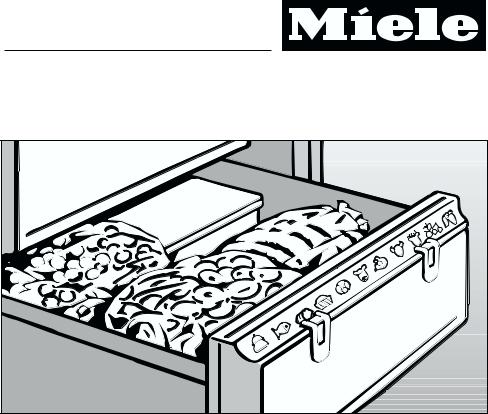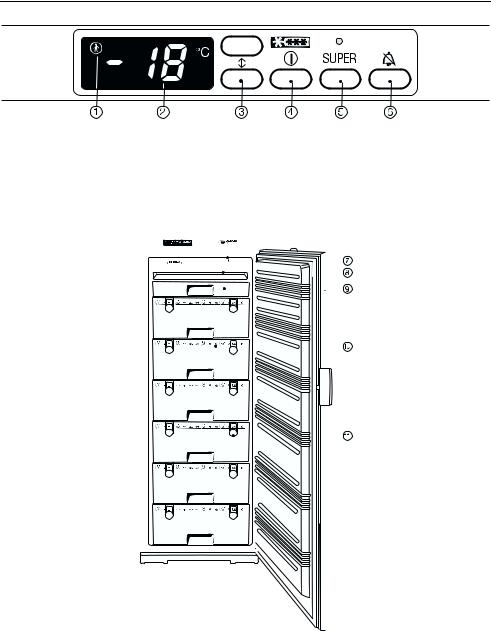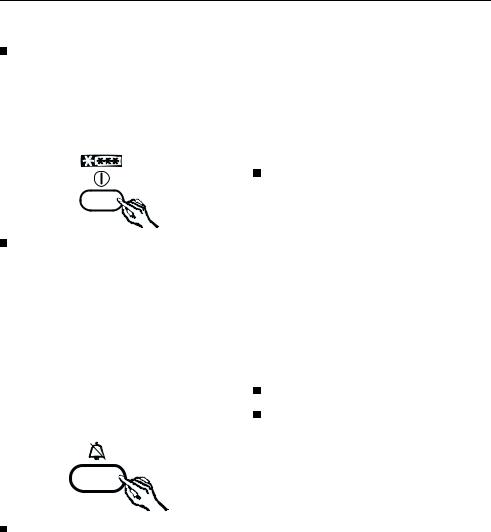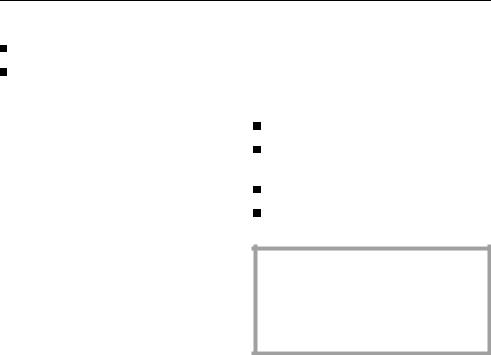Miele F 7262 SN, F 7263 SN, F 7462 SN, F 7463 SN, F 7464 SN Operating instructions
...
Operating and installation instructions
Freezer
with No-Frost-System
It is essential to read these operating instructions before installing or using the machine, to avoid the risk of accident
or damage to the machine.
Q
M.-Nr. 05 231 831

Contents
Description of the appliance . . . . . . . . . . . . . . . . . . . . . . . . . . . . . . . . . . . . . . . . . 4
Caring for the environment . . . . . . . . . . . . . . . . . . . . . . . . . . . . . . . . . . . . . . . . . . 5
Warning and safety instructions. . . . . . . . . . . . . . . . . . . . . . . . . . . . . . . . . . . . . . 6
Operation
Safety lock . . . . . . . . . . . . . . . . . . . . . . . . . . . . . . . . . . . . . . . . . . . . . . . . . . . . . . . 10 Switching off for longer periods of time . . . . . . . . . . . . . . . . . . . . . . . . . . . . . . . . . 11
The correct temperature
. . . in the freezer . . . . . . . . . . . . . . . . . . . . . . . . . . . . . . . . . . . . . . . . . . . . . . . . . . 12 Temperature selection . . . . . . . . . . . . . . . . . . . . . . . . . . . . . . . . . . . . . . . . . . . . . . 12 Temperature range . . . . . . . . . . . . . . . . . . . . . . . . . . . . . . . . . . . . . . . . . . . . . . 13 Temperature display. . . . . . . . . . . . . . . . . . . . . . . . . . . . . . . . . . . . . . . . . . . . . . . . 13 Temperature display brightness . . . . . . . . . . . . . . . . . . . . . . . . . . . . . . . . . . . . 13
Alarm
Temperature alarm . . . . . . . . . . . . . . . . . . . . . . . . . . . . . . . . . . . . . . . . . . . . . . . . . 14 Door alarm . . . . . . . . . . . . . . . . . . . . . . . . . . . . . . . . . . . . . . . . . . . . . . . . . . . . . . . 14 Switching the alarm tone off early . . . . . . . . . . . . . . . . . . . . . . . . . . . . . . . . . . . . . 14
Super freeze
Freezing fresh food . . . . . . . . . . . . . . . . . . . . . . . . . . . . . . . . . . . . . . . . . . . . . . . . 15 Switching on super freeze . . . . . . . . . . . . . . . . . . . . . . . . . . . . . . . . . . . . . . . . . . . 15 Switching super freeze off. . . . . . . . . . . . . . . . . . . . . . . . . . . . . . . . . . . . . . . . . 15
Freezing and storing food . . . . . . . . . . . . . . . . . . . . . . . . . . . . . . . . . . . . . . . . . . 16 Maximum freezing capacity . . . . . . . . . . . . . . . . . . . . . . . . . . . . . . . . . . . . . . . . . . 16 Isolation plate . . . . . . . . . . . . . . . . . . . . . . . . . . . . . . . . . . . . . . . . . . . . . . . . . . . . . 16 To take out the isolation plate:. . . . . . . . . . . . . . . . . . . . . . . . . . . . . . . . . . . . . . 16 Important. . . . . . . . . . . . . . . . . . . . . . . . . . . . . . . . . . . . . . . . . . . . . . . . . . . . . . 16 Storing frozen food . . . . . . . . . . . . . . . . . . . . . . . . . . . . . . . . . . . . . . . . . . . . . . . . 17 Home freezing . . . . . . . . . . . . . . . . . . . . . . . . . . . . . . . . . . . . . . . . . . . . . . . . . . . . 17 Hints on home freezing . . . . . . . . . . . . . . . . . . . . . . . . . . . . . . . . . . . . . . . . . . . 17 Packing . . . . . . . . . . . . . . . . . . . . . . . . . . . . . . . . . . . . . . . . . . . . . . . . . . . . . . 18 Placing food in the freezer . . . . . . . . . . . . . . . . . . . . . . . . . . . . . . . . . . . . . . . . 18 Freezer calendar . . . . . . . . . . . . . . . . . . . . . . . . . . . . . . . . . . . . . . . . . . . . . . . . . . 19

Contents
Marker system for frozen food . . . . . . . . . . . . . . . . . . . . . . . . . . . . . . . . . . . . . . . . 19 Defrosting . . . . . . . . . . . . . . . . . . . . . . . . . . . . . . . . . . . . . . . . . . . . . . . . . . . . . . . 19 Ice cubes . . . . . . . . . . . . . . . . . . . . . . . . . . . . . . . . . . . . . . . . . . . . . . . . . . . . . . . . 20 Ice cream . . . . . . . . . . . . . . . . . . . . . . . . . . . . . . . . . . . . . . . . . . . . . . . . . . . . . . . . 20 Cooling drinks . . . . . . . . . . . . . . . . . . . . . . . . . . . . . . . . . . . . . . . . . . . . . . . . . . . . 20 Freezer tray . . . . . . . . . . . . . . . . . . . . . . . . . . . . . . . . . . . . . . . . . . . . . . . . . . . . . . 20 Ice pack . . . . . . . . . . . . . . . . . . . . . . . . . . . . . . . . . . . . . . . . . . . . . . . . . . . . . . . . . 21
Defrosting . . . . . . . . . . . . . . . . . . . . . . . . . . . . . . . . . . . . . . . . . . . . . . . . . . . . . . . 22
Cleaning and care
Cleaning the outer casing, the interior and accessories . . . . . . . . . . . . . . . . . . . . 23 Ventilation gaps . . . . . . . . . . . . . . . . . . . . . . . . . . . . . . . . . . . . . . . . . . . . . . . . . . . 23 Door seals . . . . . . . . . . . . . . . . . . . . . . . . . . . . . . . . . . . . . . . . . . . . . . . . . . . . . . . 23 Metal grille at the back of the appliance . . . . . . . . . . . . . . . . . . . . . . . . . . . . . . . . 23
Problem solving guide. . . . . . . . . . . . . . . . . . . . . . . . . . . . . . . . . . . . . . . . . . . . . 25
After Sales Service. . . . . . . . . . . . . . . . . . . . . . . . . . . . . . . . . . . . . . . . . . . . . . . . 28
Electrical connection . . . . . . . . . . . . . . . . . . . . . . . . . . . . . . . . . . . . . . . . . . . . . . 29 Electrical connection U.K. . . . . . . . . . . . . . . . . . . . . . . . . . . . . . . . . . . . . . . . . . . . 29
Installation
Location . . . . . . . . . . . . . . . . . . . . . . . . . . . . . . . . . . . . . . . . . . . . . . . . . . . . . . . . . 31 Climate range . . . . . . . . . . . . . . . . . . . . . . . . . . . . . . . . . . . . . . . . . . . . . . . . . . 31 Ventilation . . . . . . . . . . . . . . . . . . . . . . . . . . . . . . . . . . . . . . . . . . . . . . . . . . . . . . . . 31 Fitting the handle . . . . . . . . . . . . . . . . . . . . . . . . . . . . . . . . . . . . . . . . . . . . . . . . . . 31 Installation . . . . . . . . . . . . . . . . . . . . . . . . . . . . . . . . . . . . . . . . . . . . . . . . . . . . . . . 32 Align the appliance . . . . . . . . . . . . . . . . . . . . . . . . . . . . . . . . . . . . . . . . . . . . . . . . 32
Changing the door hinging . . . . . . . . . . . . . . . . . . . . . . . . . . . . . . . . . . . . . . . . 33

Description of the appliance
bSafety lock indicator light |
eOn/Off button |
|||||||||||||||||||
cTemperature display |
fSuper freeze button and indicator |
|||||||||||||||||||
dTemperature selector buttons |
|
|
light |
|||||||||||||||||
|
|
|
|
|
|
|
|
|||||||||||||
(upper button: warmer; |
gAlarm button |
|||||||||||||||||||
lower button: colder) |
|
|
|
|
|
|
|
|
||||||||||||
|
|
|
|
|
|
|
|
|
|
|
|
|
|
|
|
|
|
|
|
|
|
|
|
|
|
|
|
|
|
|
|
|
|
|
|
|
|
|
|
|
|
|
|
|
|
|
|
|
|
|
|
|
|
|
|
|
|
|
|
|
|
|
|
|
|
|
|
|
|
|
|
|
|
|
|
|
|
|
|
|
|
|
|
|
|
|
|
|
|
|
|
|
|
|
|
|
|
|
|
|
|
|
|
|
|
|
|
|
|
|
|
|
|
|
|
|
|
|
|
|
|
|
|
|
|
|
|
|
|
|
|
|
|
|
|
|
|
|
|
|
|
|
|
|
|
|
|
|
|
|
|
|
|
|
|
|
|
|
|
|
|
|
|
|
|
|
|
|
|
|
|
|
|
|
|
|
|
|
|
|
|
|
|
|
|
|
|
|
|
|
|
|
|
|
|
|
|
|
|
|
|
|
|
|
|
|
|
|
|
|
|
|
|
|
|
|
|
|
|
|
|
|
|
|
|
|
|
|
|
|
|
|
|
|
|
|
|
|
|
|
|
|
|
|
|
|
|
|
|
|
|
|
|
|
|
|
|
|
|
|
|
|
|
|
|
|
|
|
|
|
|
|
|
|
|
|
|
|
|
|
|
|
|
|
|
|
|
|
|
|
|
|
|
|
|
|
|
|
|
|
|
|
|
|
|
|
|
|
|
|
|
|
|
|
|
|
|
|
|
|
|
|
|
|
|
|
|
|
|
|
|
|
|
|
|
|
|
|
|
|
|
|
|
|
|
|
|
|
|
|
|
|
|
|
|
|
|
|
|
|
|
|
|
|
|
|
|
|
|
|
|
|
|
|
|
|
|
|
|
|
|
|
|
|
|
|
|
|
|
|
|
|
|
|
|
|
|
|
|
|
|
|
|
|
|
|
|
|
|
|
|
|
|
|
|
|
|
|
|
|
|
|
|
|
|
|
|
|
|
|
|
|
|
|
|
|
|
|
|
|
hInterior lighting iNo-frost system jFreezer tray
kDrawers with freezer calendar
lMarker system for frozen food
4

Caring for the environment
Disposal of the packing material
The transport and protective packing has been selected from materials which are environmentally friendly for disposal and can normally be recycled.
Rather than just throwing these materials away, please ensure they are offered for recycling.
Ensure that any plastic wrappings, bags etc. are disposed of safely and kept out of the reach of babies and young children. Danger of suffocation!
Disposal of your old appliance
Old appliances contain materials which can be reclaimed or recycled. Please contact your dealer, your waste collection centre or scrap merchant about potential recycling schemes.
Make sure that the pipework is not damaged whilst moving an old appliance. This is to ensure that the refrigerant and oil in the compressor cannot leak into the environment. It is important that they are disposed of in a safe manner by authorised persons only.
Ensure that the appliance presents no danger to children while being stored for disposal.
See the appropriate section in the Warning and safety instructions.
5

Warning and safety instructions
This appliance complies with all relevant legal safety requirements. Improper use of the appliance can, however, present a risk of both personal injury and material damage.
Before installation and before using for the first time, read the operating instructions carefully. They contain important notes on safety, the operation and care of the appliance.
This way you will avoid the risk of accidents and damage to the appliance.
Keep these instructions in a safe place and pass them on to any future user.
Correct usage
This appliance is intended for domestic use only. It must only be
used for storing deep frozen food, for freezing fresh food and for preparing ice. Any other usage is not supported by the manufacturer and could be dangerous. The manufacturer cannot be held responsible for damage caused by improper use of the appliance.
Technical safety
This appliance contains the coolant Isobutane (R600a), a natural gas which breaks down naturally. It is
however flammable. Care must be taken during transportation and setting up of the appliance that no parts of the cooling system are damaged. Leaking refrigerant can damage the eyes.
In the event of refrigerant escaping:
–avoid open fires
and anything which creates a spark,
–disconnect from the mains,
–air the room in which the appliance is located for several minutes and
–contact the Service Department. for advice.
The more refrigerant there is in an appliance the larger the room it
should be installed in. In the event of a leakage, if the appliance is in a small room, there is the danger of combustible gases building up.
For every 8 g of coolant at least 1 m3 room space is required. The amount of coolant in the appliance is stated on the data plate inside the appliance.
Before connecting the appliance to the mains supply, make sure that
the rating on the data plate corresponds to the voltage and frequency of the household supply.
This data must correspond in order to avoid risk of damage to the appliance. If in any doubt, consult a qualified electrician.
6

Warning and safety instructions
The electrical safety of this appliance can only be guaranteed
when continuity is complete between the appliance and an effective earthing system which complies with local and national safety regulations. It is most important that this basic safety requirement is tested by a qualified electrician.
The manufacturer cannot be held responsible for the consequences of an inadequate earthing system (e.g. electric shock).
Safe operation of the appliance is only assured if it has been installed
and connected in accordance with these operating and installation instructions.
Installation work, maintenance and repairs may only be carried out by
suitably qualified and competent persons.
Repairs and other work by unqualified persons could be dangerous and the manufacturer will not be held responsible.
Ensure current is not supplied to the appliance while maintenance
or repair work is being carried out.
The appliance is only completely isolated from the electricity supply
when:
–the plug has been withdrawn.
Do not pull on the cable, only on the plug.
–the mains fuse is withdrawn.
–or the screw-out fuse is removed (in countries where this is applicable).
Do not connect the appliance to the mains electricity supply by an
extension lead.
Extension leads do not guarantee the required safety of the appliance. (e.g. danger of overheating).
Use
Never handle frozen food with wet hands. Your hands may freeze to the frozen food. Danger of frost burn.
Do not take ice cubes out with your bare hands and never place
ice cubes or ice lollies in your mouth straight from the freezer. The very low temperature of the frozen ice or lollies can cause frost burn to the lips and tongue.
Do not refreeze thawed or partially thawed food.
Defrosted food should be used as quickly as possible as food soon loses its nutritional value and goes off. Defrosted food may only be re-frozen after it has been cooked.
Never store explosive materials in the appliance.
Switching on thermostats may produce sparks which could present a fire hazard.
Do not store cans or bottles containing carbonated drinks or
liquids which could freeze in the freezer. The cans or bottles could explode. Danger of injury and damage to the appliance.
7

Warning and safety instructions
When cooling drinks quickly in the freezer make sure bottles are not
left in for more than one hour, otherwise they could burst. Danger of injury and damage to the appliance.
Observe the "use by" dates given on food to avoid the risk of food
poisoning. Storage times will depend on several factors including the freshness and quality of the food as well as the temperature at which it is stored.
Follow the instructions given on food manufacturer’s packaging on storage conditions required as well as the "use by" date.
Do not use sharp edged objects to
–remove frost and ice,
–separate frozen foods and remove ice trays.
They will damage the evaporator and the appliance will not be able to be used again (total damage).
Never place electric heaters or candles in the appliance to defrost
it. These can damage the plastic parts.
Do not use defrosting sprays, or de-icers as they could contain sub-
stances which could damage the plastic parts and which may cause the build up of gases and pose a danger to health.
Do not use any grease or oil on the door seals. These cause the seals to become porous in the course of time.
Do not block the ventilation gaps in the appliance as this would impair the efficiency of the appliance, increase the electricity consumption and could cause damage to the appliance.
The appliance is designed for use within certain climate ranges (am-
bient temperatures). It must not be used in ranges for which it is not designed. The climate range for your appliance is stated on the data plate inside the appliance. Installing it in a room with too low an ambient temperature will lead to the appliance switching off for longer periods so that it cannot maintain the required temperature.
Never use steam cleaning apparatus to defrost or clean the ap-
pliance. The steam could attack the electrical components and cause a short circuit.
In countries where there are areas which may be subject to infesta-
tion by cockroaches or other vermin, pay particular attention to keeping the appliance and its surroundings in a clean condition at all times. Any damage which may be caused by cockroaches or other vermin will not be covered by the appliance guarantee.
8

Warning and safety instructions
Disposal of old appliances
Before disposing of an old appliance first make the door latch or
lock unusable.
This way you will prevent children from accidentally locking themselves in and endangering their lives.
Before disposing of an old appliance, unplug it and render the
plug useless. Cut off the cable directly behind the appliance and at the plug to prevent misuse.
Be careful not to damage any part of the pipework whilst awaiting dis-
posal, e.g. by
–puncturing the refrigerant channels in the evaporator.
–bending any pipework.
–scratching the surface coating. Splashes of refrigerant can damage the eyes.
The manufacturer cannot be held liable for damage caused by noncompliance with these Warning and safety instructions.
9

Operation
Before using for the first time
Clean the inside of the appliance and the accessories with luke warm water and a little washing up liquid and then dry using a soft cloth.
Switching on
Press the "On/Off" button.
Bars appear in the temperature display and the alarm sounds. The appliance starts cooling. The interior light will come on if the door is opened.
Allow the freezer to run for a few hours before placing food in it. This will ensure that the temperature in the freezer is sufficiently low.
Switching off the alarm
Press the alarm button.
The alarm stops.The bars will continue to flash in the temperature display until the temperature range set has been reached.
Ice pack
Place the ice pack in the top drawer or to save space in the freezer tray. The ice pack will be at its most effective after it has been in the freezer for approx. 24 hours.
Switching off
Press the "On/Off" button.
The temperature display goes out. The cooling process is switched off. (If this does not happen the safety lock is still engaged.)
Safety lock
The safety lock can be engaged to prevent the appliance being switched off inadvertently.
Engaging the safety lock.
Press and hold in the alarm button.
Then press the Super freeze button as well, and keep both buttons pressed in for approx. 3 seconds until the Safety lock indicator light d in the temperature display lights up and a beep is heard.
The appliance can now not be switched off until the safety lock is switched off.
10

Operation
Switching off the safety lock
Press and hold in the alarm button.
Then press the Super freeze button as well, and keep both buttons pressed in for approx. 3 seconds until the Safety lock indicator light d in the temperature display goes out. The appliance can be switched off now.
Switching off for longer periods of time
If the appliance is not going to be used for a longer period of time, e.g. whilst on holiday
switch the appliance off at the mains,
withdraw the plug (pull on the plug and not the cable),
defrost and clean the appliance,
leave the door ajar to air the appliance.
If, during a long absence, the appliance is switched off but not cleaned out and the door is left shut there is a danger of mould and odours building up inside the appliance.
11
